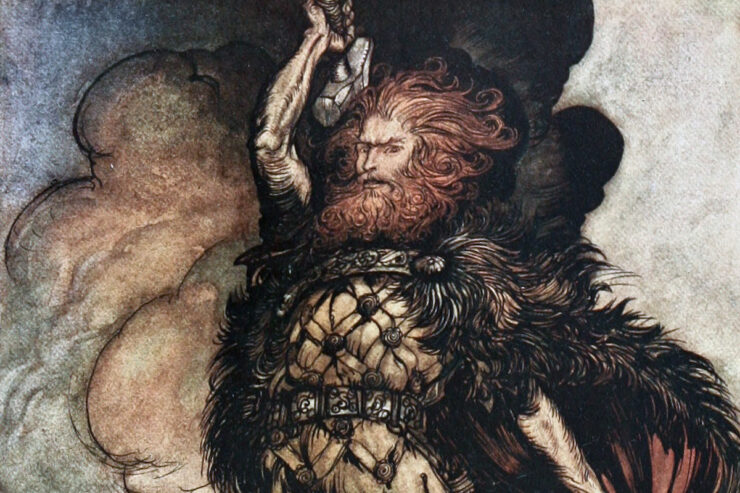
reactormag.com
Tracing the Origins of Modern Fantasy in Five Classic Viking Tales
Books
Norse mythology
Tracing the Origins of Modern Fantasy in Five Classic Viking Tales
If you’re a fan of stories about rings and riddles, elves and dragons, here’s where to start reading the sagas and tales that inspired Tolkien and many others…
By Rowdy Geirsson
|
Published on July 11, 2024
Illustration by Arthur Rackham (from The Rhinegold & the Valkyrie, 1910)
Comment
0
Share New
Share
Illustration by Arthur Rackham (from The Rhinegold & the Valkyrie, 1910)
It’s commonly acknowledged that modern Western fantasy owes a lot to the myths and legendary stories of the Vikings and their forebears. From the iconic representations of elves and dwarves to the prevalence of magical swords and rings, Norse lore has provided a goldmine of inspiration for writers in the modern period. As most fantasy fans know, J.R.R. Tolkien pulled heavily (albeit not exclusively) from the Norse lore for his stories of Middle-earth—“Middle-earth” itself one of several possible translations for the human world found in the Norse myths. And given Tolkien’s importance and influence, it’s perhaps not surprising that his works set a tone for modern fantasy in general that remains relevant and palpable to this day.
But what about the ancient stories themselves? While typically the domain of academics and more serious students and fans of specifically Norse lore, the myths and legendary sagas (a specific category of Norse sagas known as fornaldarsagor—literally, “stories of ancient times”) also offer quite a lot of entertainment value as well as educational value to more casual readers of modern fantasy. These are stories full of magic and monsters, evil-doers and heroes and heroines. Most were recorded in Iceland after the Viking Age but concern both historical and fictitious events that occurred prior to the Viking Age. These stories were predominately written in prose—they tend to read like a modern novel stripped of any superfluous, descriptive language all the way down to the bare bones of the narrative. The following selections are the best of the bunch to begin with for anyone who’s interested in exploring this fantastical world.
The Eddas
The Poetic Edda translated by Carolyne Larrington
The Prose Edda translated by Anthony Faulkes (published simply as Edda)
The Eddas are the main sources of Norse mythology. There are two: The Poetic Edda and The Prose Edda, and both were recorded in Iceland after the end of the Viking Age ( a third, parodic Edda also exists). While there are other sources of Norse mythology, the Eddas form the bulk of our knowledge on the subject and there is a fair amount of overlap. The Eddas are where you’ll find most of the familiar stories of Odin, Thor, Freyja, Loki, and all the other members of the Norse pantheon. The Eddas also set down many of the fantasy tropes with which we are so familiar: tall, noble, nearly god-like elves; metalworking dwarves who dwell below ground; mysterious, cloaked wanderers; extremely powerful magical weapons and artifacts; very large, highly intelligent eagles; and fateful battles-to-end-all-battles. As their names imply, The Poetic Edda was written in poetic verse (anonymously) and The Prose Edda was written in prose (by Snorri Sturluson). Consequently, The Prose Edda is the easier of the two to initially dive into, but The Poetic Edda is more ancient in its origins, in terms of its actual text, because many of its verses are thought to have originated in pre-literate Nordic society, surviving the passage of time till their recording in the 12th century. In both volumes, fantasy fans will find much that *rings* familiar… (terrible pun intended).
The Saga of the Volsungs
The Saga of the Volsungs translated by Jackson Crawford in The Saga of the Volsungs with The Saga of Ragnar Lothbrok
The Saga of the Volsungs is probably the most renowned of the legendary Norse sagas. It’s a multi-generational epic and elements of its narrative are also found in The Poetic Edda as well as other noteworthy, medieval texts such as the German Nibelungenlied. However, the story itself is rooted in a much older era that predates the Viking Age. In fact, the action takes place mostly in modern-day France and Germany rather than Scandinavia. But the characters—especially the star-crossed lovers of Sigurd and Brynhild—were renowned throughout the ancient Germanic world and consequently played a major role in Norse lore at the time of the Vikings. This is the story that served as the primary inspiration for Richard Wagner’s Ring Cycle and one of the major inspirations for Tolkien’s Lord of the Rings; a critical sequence in its plot focuses on a particularly powerful, cursed ring. The Saga of the Volsungs also includes werewolves, supernatural swords, gold-hoarding dragons, talking birds, and a devastating, inevitable sense of fate. It’s an incredibly violent and brutal tale that eschews all prevailing modern sensibilities and sensitivities; today’s grimdark subgenre can eat its heart out (if you know, you know).
Hrolf Kraki’s Saga
Hrolf Kraki and His Champions translated by Jackson Crawford in Two Sagas of Mythical Heroes
King Hrolf Kraki is often considered to be Scandinavia’s answer to King Arthur, and there are certainly some similarities. Like King Arthur, King Hrolf is a good and just king who leads an entourage of warriors who are also good and just, if not necessarily chivalric. Sometimes King Hrolf and his men go on adventures together; sometimes they go on adventures solo. As with the other tales on this list, the character of King Hrolf also appears in other sources, but his eponymous saga is the most fun. In it, readers will encounter two of the most legendary locales found in the whole Viking world—Lejre in Denmark and Uppsala in Sweden—as well as legendary figures with names like Svipdag, Thorir Hound’s Foot, Bodvar Bjarki, and a whole lot of berserkers. Hrolf Kraki’s Saga features mysterious elf women, characters who are half-human and half-animal, boar-trolls, shape-shifting warriors, armies risen from the dead, and recurring feats of witchcraft and wizardry learned in an era before such arcane skills were ever formalized and taught in certain renowned British educational institutions.
The Saga of Hervor and Heidrek
Hervor and Heidrek translated by Jackson Crawford in Two Sagas of Mythical Heroes
As far as stories involving cursed weapons go, The Saga of Hervor and Heidrek is pretty tough to beat. Tyrfing was an amazing sword even before it was cursed: it was exceedingly sharp and shone like the rays of the sun. As you might expect, it was made by dwarves, one of whom was the original Dvalin. But the dwarves cursed the sword so that each time it is unsheathed it will kill someone and will eventually bring about three evil deeds. So, naturally, everyone wants this sword. The saga is another multi-generational affair and, like The Saga of the Volsungs, veers into territory involving epic battles with the Huns. The title characters are a mother and son duo, both of whom engage in some seriously violent conflicts. In addition to long-lasting weapon-magic, The Saga of Hervor and Heidrek also includes necromancy, gods walking among men, a very intense game of riddles, and a character who is probably the most badass shield-maiden of them all (sorry, Lagertha).
Arrow-Odd’s Saga
Arrow-Odd translated by Hermann Pálsson and Paul Edwards in Seven Viking Romances
You know you’re in for a fun story when the titular character himself is named for his weapon of choice: dwarf-crafted magical arrows that work kind of like a boomerang, always returning safely to the archer. Arrow-Odd’s Saga follows the exploits of Arrow-Odd as he journeys around the world and into supernatural realms, vanquishing evil-doers and monsters, and crossing paths with some of the heroes also found in The Saga of Hervor and Heidrek (and he also appears as a side character in that saga, too). It’s all to avoid the fate of being killed by his own horse’s skull, as foretold by a seeress when he was just a young lad. Arrow-Odd’s Saga is a meandering, action-packed adventure story replete with witchcraft, sea monsters, giants, and an inescapable prophecy that predates the modern-day cliché by centuries.
[end-mark]
The post Tracing the Origins of Modern Fantasy in Five Classic Viking Tales appeared first on Reactor.
















